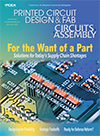The art of designing TFT modules in America is trending downward. It doesn’t have to.
In today’s rapidly evolving tech landscape, engineers may not be as well-informed on TFT module optimization as counterparts in Asia. (TFT modules are a type of liquid crystal display panel.) The knowledge gap can be attributed to various factors, leading to American-based EMS providers to operate with a less comprehensive understanding of the latest TFT technology. To the American EMS, it is worth considering the discrepancies in knowledge and areas to focus on.
Nonstop production, no matter the volume.
In the fast-paced world of surface-mount technology (SMT), every second matters. As demand rises for quickturn prototypes, smaller lot sizes and just-in-time manufacturing, businesses face increasing pressure to reduce downtime and minimize waste. In this environment, reel splicing kits have evolved from a niche accessory into an essential tool for optimizing SMT operations.
Whether running high-mix, low-volume builds or driving 24/7 production on high-volume lines, reel splicing kits remain one of the most cost-effective solutions to enhance feeder setup, streamline changeover and improve inventory efficiency.
 As the booths are rolled up and the last coffee cup is cleared from the Boxboro Regency, I find myself reflecting on my first PCB East – equal parts conference, class reunion and boot camp in the best possible way.
As the booths are rolled up and the last coffee cup is cleared from the Boxboro Regency, I find myself reflecting on my first PCB East – equal parts conference, class reunion and boot camp in the best possible way.
An analysis of copper shorting caused by moisture and various residues.
Moisture reacts with high levels of weak organic acids, chloride and sulfate residues, leading to copper shorting. Poor adhesion from a low-pressure overmold exacerbates the issue.
The corrosive residues then dissolve the copper at the edges of the solder pads, and voltage bias drives the formation of dendrites. This creates a small gap at the board surface interface that permits moisture to ingress. The resulting colorful metal short exhibits is a result of the different states of the copper, voltage influences and organic materials from the substrate surface, which has titanium and silica in the white solder mask.
The market for recycled electronics, and what companies can do with excess stock.
Circularity and inventory management intersect two key areas for electronics manufacturers. They are problems as old as the industry. In the early 1990s, for instance, an entrepreneur named Jerry Haller had an idea for a component exchange system set up much like trading financial stocks on Wall Street. He called the operation Fast Parts. It never caught on, however, nor did the many attempts others made to emulate it.
A few decades later, however, the industry might finally be ready for sustainable resource management.
The time is now for serial inventor Joe Fjelstad’s answer to simplifying component assembly.
Joe Fjelstad is a renowned innovator, environmental advocate and the visionary mind behind the Occam Process, a groundbreaking advancement in electronics manufacturing. In this in-depth conversation, Fjelstad shares the journey of Occam, its transformative potential, and the wisdom gathered over his illustrious career.
Press Releases
- Altus Reports Growing Demand for Guidance on Convection Reflow Oven Specification
- Coherix Opens New Adhesive-Dispensing Vision Center in Europe
- Pan Pacific Strategic Electronics Symposium Program Finalized
- The Most Critical 2 Inches in SMT Manufacturing – When a Splice Fails, the Line Fails, Full Stop. Throughput and Yield Depend on One Overlooked Moment


